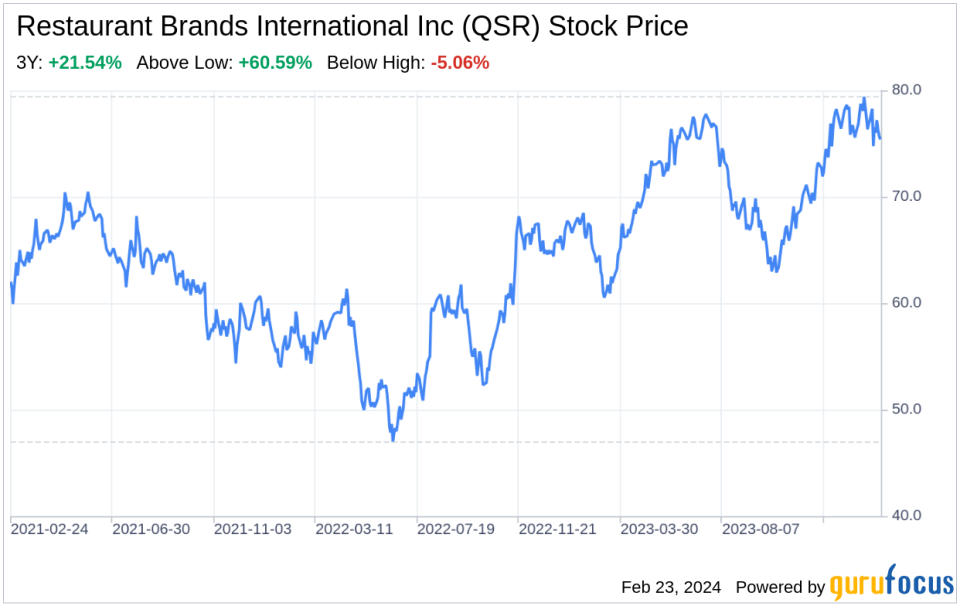Decoding Restaurant Brands International Inc (QSR): A Strategic SWOT Insight
Strengths highlight the company's robust brand portfolio and global presence.
Weaknesses underscore challenges in competitive differentiation and market saturation.
Opportunities emphasize potential in digital expansion and international markets.
Threats include intense industry competition and changing consumer preferences.
Restaurant Brands International Inc (NYSE:QSR) filed its 10-K on February 22, 2024, revealing a financial landscape that reflects the company's expansive reach and operational efficiency. With approximately $43 billion in 2023 systemwide sales and a presence in over 100 countries, QSR continues to leverage its portfolio of over 31,000 restaurants, including Burger King, Tim Hortons, Popeyes Louisiana Kitchen, and Firehouse Subs. The company's revenue streams are diverse, encompassing retail sales from company-owned restaurants, royalties, lease income from franchised stores, and supply chain operations. The financial tables within the filing indicate a solid foundation, with a market capitalization of $23.9 billion as of June 30, 2023, and a commitment to growth and innovation that positions QSR as a formidable player in the quick service restaurant (NYSE:QSR) industry.

Strengths
Global Brand Portfolio: Restaurant Brands International Inc's (NYSE:QSR) strength lies in its diverse and globally recognized brand portfolio. With brands like Burger King, Tim Hortons, Popeyes Louisiana Kitchen, and Firehouse Subs, QSR has established a significant presence in the QSR industry. The company's systemwide sales of approximately $43 billion in 2023 reflect the power of its brands and their appeal across various demographics and geographies. The strategic positioning of each brand allows for a complementary mix of products and services, catering to different customer preferences and meal occasions.
Franchise Model and Supply Chain Operations: QSR's predominantly franchised business model is another strength, offering scalability and reduced operational risk. As of year-end 2023, nearly all restaurants under its brands were franchised, which underscores the company's ability to expand its global footprint with limited capital expenditure. Additionally, the Tim Hortons supply chain operations provide a stable revenue source and control over product quality, contributing to the overall strength of the brand and the company's financial health.
Weaknesses
Market Saturation and Differentiation Challenges: Despite its strong brand presence, Restaurant Brands International Inc faces challenges in differentiating itself in a saturated market. The QSR industry is known for its intense competition, and QSR's large portfolio, while a strength, also necessitates continuous innovation to stay ahead. The company must navigate the delicate balance of maintaining brand identity while evolving to meet changing consumer tastes and preferences.
Reliance on Franchisee Performance: The company's reliance on franchised restaurants also presents a weakness, as inconsistencies in franchisee performance can impact the overall brand image and customer experience. While franchising allows for rapid expansion and reduced capital costs, it also requires rigorous oversight and support to ensure that franchisees uphold the company's standards of quality and service.
Opportunities
Digital Expansion and Technological Innovation: Restaurant Brands International Inc has significant opportunities to enhance its digital footprint and leverage technology to improve customer experience. The company's investment in mobile apps, loyalty programs, and modernizing the drive-thru experience are steps in the right direction. Expanding these initiatives can lead to increased customer engagement, streamlined operations, and higher sales.
International Market Penetration: With a presence in over 100 countries, QSR has the opportunity to further penetrate international markets, particularly in regions where the QSR industry is still growing. Strategic partnerships, master franchise agreements, and joint ventures can accelerate this international expansion, tapping into new customer bases and driving systemwide sales growth.
Threats
Intense Industry Competition: The QSR industry is highly competitive, with low barriers to entry and a plethora of well-capitalized regional, national, and international chains. Restaurant Brands International Inc must continuously innovate and adapt to maintain its market share amidst fierce competition. The company's ability to attract and retain customers, as well as qualified franchisees, is crucial to its long-term success.
Changing Consumer Preferences: Consumer preferences in the food industry are rapidly evolving, with increasing demand for healthier options, sustainable practices, and ethical sourcing. QSR must navigate these changes and adapt its offerings accordingly to avoid losing relevance and market share. Failure to align with consumer expectations could lead to a decline in sales and profitability.
In conclusion, Restaurant Brands International Inc (NYSE:QSR) demonstrates a robust foundation with its strong brand portfolio, global presence, and diversified revenue streams. However, the company must address its weaknesses, such as market saturation and reliance on franchisee performance, to maintain its competitive edge. The opportunities for digital expansion and international market penetration present pathways for growth, while threats from intense competition and changing consumer preferences require strategic focus and adaptability. Overall, QSR's SWOT analysis reveals a company with the potential to further solidify its position in the QSR industry, provided it effectively leverages its strengths, addresses its weaknesses, capitalizes on opportunities, and mitigates threats.
This article, generated by GuruFocus, is designed to provide general insights and is not tailored financial advice. Our commentary is rooted in historical data and analyst projections, utilizing an impartial methodology, and is not intended to serve as specific investment guidance. It does not formulate a recommendation to purchase or divest any stock and does not consider individual investment objectives or financial circumstances. Our objective is to deliver long-term, fundamental data-driven analysis. Be aware that our analysis might not incorporate the most recent, price-sensitive company announcements or qualitative information. GuruFocus holds no position in the stocks mentioned herein.
This article first appeared on GuruFocus.
